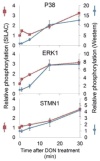Global protein phosphorylation dynamics during deoxynivalenol-induced ribotoxic stress response in the macrophage
- PMID: 23352502
- PMCID: PMC4041276
- DOI: 10.1016/j.taap.2013.01.007
Global protein phosphorylation dynamics during deoxynivalenol-induced ribotoxic stress response in the macrophage
Abstract
Deoxynivalenol (DON), a trichothecene mycotoxin produced by Fusarium that commonly contaminates food, is capable of activating mononuclear phagocytes of the innate immune system via a process termed the ribotoxic stress response (RSR). To encapture global signaling events mediating RSR, we quantified the early temporal (≤30min) phosphoproteome changes that occurred in RAW 264.7 murine macrophage during exposure to a toxicologically relevant concentration of DON (250ng/mL). Large-scale phosphoproteomic analysis employing stable isotope labeling of amino acids in cell culture (SILAC) in conjunction with titanium dioxide chromatography revealed that DON significantly upregulated or downregulated phosphorylation of 188 proteins at both known and yet-to-be functionally characterized phosphosites. DON-induced RSR is extremely complex and goes far beyond its prior known capacity to inhibit translation and activate MAPKs. Transcriptional regulation was the main target during early DON-induced RSR, covering over 20% of the altered phosphoproteins as indicated by Gene Ontology annotation and including transcription factors/cofactors and epigenetic modulators. Other biological processes impacted included cell cycle, RNA processing, translation, ribosome biogenesis, monocyte differentiation and cytoskeleton organization. Some of these processes could be mediated by signaling networks involving MAPK-, NFκB-, AKT- and AMPK-linked pathways. Fuzzy c-means clustering revealed that DON-regulated phosphosites could be discretely classified with regard to the kinetics of phosphorylation/dephosphorylation. The cellular response networks identified provide a template for further exploration of the mechanisms of trichothecenemycotoxins and other ribotoxins, and ultimately, could contribute to improved mechanism-based human health risk assessment.
Copyright © 2013 Elsevier Inc. All rights reserved.
Conflict of interest statement
The authors declare no conflict of interest.
Figures










References
-
- Andersen ME, Krewski D. Toxicity testing in the 21st century: bringing the vision to life. Toxicol Sci. 2009;107:324–330. - PubMed
-
- Azcona-Olivera JI, Ouyang Y, Murtha J, Chu FS, Pestka JJ. Induction of cytokine mRNAs in mice after oral exposure to the trichothecene vomitoxin (deoxynivalenol): relationship to toxin distribution and protein synthesis inhibition. Toxicology and applied pharmacology. 1995;133:109–120. - PubMed
Publication types
MeSH terms
Substances
Grants and funding
LinkOut - more resources
Full Text Sources
Other Literature Sources

